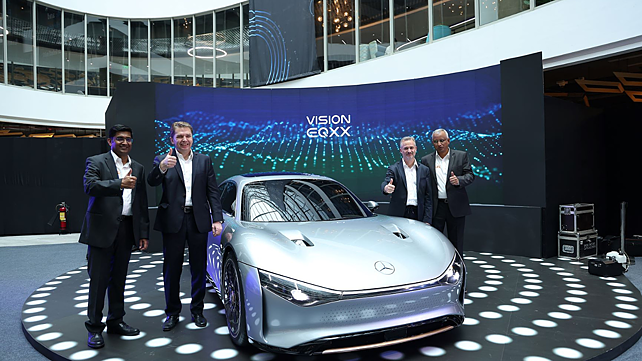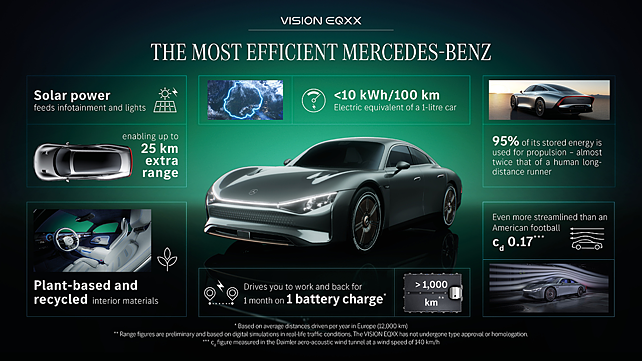
Mercedes-Benz Research and Development India (MBRDI) has launched ‘Safe Roads’ to create awareness about the significance of road safety, and share best practices with future road users, to reduce India’s alarmingly high road accident fatality rate, Manu Saale, Managing Director and CEO, has said.
Hosting the third edition of Safe Roads India Summit (SRIS) in Bengaluru, Saale said, 'Our journey of promoting road safety across the country, first, through road shows in eight cities and now with the SRIS, has been very fulfilling.”
Driven by the idea of zero impact on the planet and highly responsible use of green energy, Mercedes-Benz developed Vision EQXX, recognised as the world’s most advanced and efficient vehicle. This research prototype is packed with developments and innovations contributing to its range. It can exceed 1,000 kilometres of real-world electric driving on one charge and clearly indicates the company's route as it strives to be all-electric by 2030. It is a part of a wider technology programme to push the boundaries of technical feasibility and to speed up the transfer of innovations to series production. MBRDI engineers based in Bangalore and Pune have contributed significantly to building this prototype, which has been recognised as the new benchmark for EVs.
Vision EQXX
In line with the theme of ‘Leading Safety with Sustainability at the Core’, the world’s most efficient electric vehicle - Mercedes-Benz Vision EQXX, was unveiled for the first time in India by Saale along with Prof Paul Dick, Head of Vehicle Safety, Mercedes-Benz AG, and Jochen Feese, Head of Accident Research, Concepts & Sensor-based Safety Systems, Mercedes-Benz AG, during the event.
Safety is a core value for Mercedes-Benz and its automotive brands, which are renowned worldwide for highly sophisticated safety systems. In line with United Nations Sustainable Development Goals (SDG 3.6 and SDG 11.2), Mercedes-Benz recently announced its Vision ZERO 2050, committing to reduce road fatalities to 50% by 2030, as per the 2020 numbers, and achieve the goal of accident-free driving globally, by 2050. This ambition is fuelled by a ‘real-life safety’ philosophy and powered by the Group’s own Accident Research unit, which has analysed real-world accidents for over 50 years. In recent years, the research was expanded to include some locations in India to make accident-free driving a reality across all markets. However, the effectiveness of safety systems can be compromised if road users do not comply with traffic rules or use the safety systems onboard their vehicles.
Prof Dick said, “SAFE ROADS is a commendable initiative that underlines all aspects of road safety comprehensively and will go a long way in making Indian roads safer. To reinforce our commitment to make roads safer, globally, we announced our commitment to the vision of accident-free driving by 2050. This is our holistic and data driven approach to protect all road users with both active and passive safety systems, and we are committed to making this a reality.”

Saale said Vision EQXX is a testament to MBRDI's development approach. It underlines the company's spirit, technological leadership and expertise in electric cars and positions Mercedes-Benz as a leading tech brand. 'I am proud to share that MBRDI has contributed extensively towards the development of Vision EQXX. Over the years, we have established ourselves as an innovation powerhouse with some aspects of every Mercedes-Benz car touched, modified, developed, and supported by India.'
As part of the programme, MBRDI has showcased a few technological solutions.
EQS BiW
A Body in White (BiW) passenger car exhibit highlighted some of the core elements of a car structure which have a high tensile strength that can absorb most of the energy during a crash and minimise passenger car intrusions. In addition, safety sensors and restraint system components are visible.
Alcohol Goggles:
Alcohol goggles provide a unique experience. Wearing these special types of glasses simulates the common ‘walk-the-line’ activity which causes loss of balance and delayed reaction times.
Also Read
Mercedes-Benz Raises The Bar On Road Safety
Vision EQXX Takes To The Road To Prove Its Capabilities